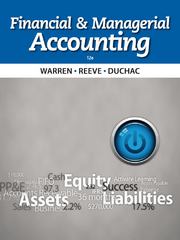Question
Which of the following is a benefit of selling on credit? Question 3 options: Cash is received sooner. Expenses are reduced by making sales to
Which of the following is a benefit of selling on credit? Question 3 options:
Cash is received sooner.
Expenses are reduced by making sales to a wide range of customers.
Revenues are increased by making sales to a wider range of customers.
Some customers do not pay, creating an expense.
The balance sheet reports accounts receivable at: Question 4 options:
market value.
fair value.
lower-of-cost-or-market.
historical cost.
The current credit balance in allowance for doubtful accounts is $150. Management estimates that 2.5% of net credit sales of $105,000 will be uncollectible. Based on the foregoing data, what is the bad-debt expense balance on the income statement? Question 6 options:
$2,775
$2,625
$2,475
$2,650
Allowance for doubtful accounts has a credit balance of $900 at the end of the current year (prior to adjustment). An analysis of the aged accounts in the customers' ledger indicates uncollectible accounts of $16,000. The adjusting entry would require a debit to: Question 7 options:
allowance for doubtful accounts for $15,100.
allowance for doubtful accounts for $16,900.
bad-debt expense for $15,100.
bad-debt expense for $16,900.
The current debit balance in allowance for doubtful accounts is $465. Management estimates that 3% of net credit sales of $205,000 will be uncollectible. Based on the foregoing data, what is the allowance for doubtful accounts balance on the balance sheet? Question 8 options:
$6,615
$5,685
$465
$6,150
Mandy Smith's account was written off last year. She owed City Company $5,000. Using the allowance method, the journal entry to reinstate her account involves: Question 9 options:
a debit to bad-debt expense and a credit to Smith's account receivable.
a debit to Smith's account receivable and a credit to bad-debt expense.
a debit to Smith's account receivable and a credit to allowance for doubtful accounts.
a debit to allowance for doubtful accounts and a credit to Smith's account receivable.
Using the balance-sheet approach to estimate uncollectibles, accounts that are 90 days old are: Question 10 options:
more likely to be collected than accounts 30 days old.
less likely to be collected than accounts 30 days old.
less likely to be collected than accounts 360 days old.
equally likely to be collected as accounts 360 days old.
Step by Step Solution
There are 3 Steps involved in it
Step: 1

Get Instant Access to Expert-Tailored Solutions
See step-by-step solutions with expert insights and AI powered tools for academic success
Step: 2

Step: 3

Ace Your Homework with AI
Get the answers you need in no time with our AI-driven, step-by-step assistance
Get Started


